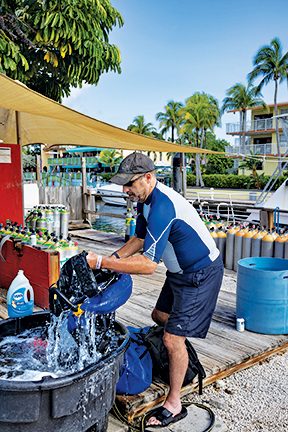AFTER THE INITAL SCARE AND LOCKDOWNS FROM COVID-19, divers soon started to explore ways to safely get back into the water. Disinfection has always been a consideration in diving, but we needed new standards to allay fears of uncontrolled transmission of infectious diseases.
Fortunately, the industry responded rapidly to provide sufficient confidence to resume dive operations. We don’t have significant evidence of mass infections on dive boats, around dive sites, or in classrooms or retail shops, so it’s likely that the processes we followed played a major role in ensuring that diving was not a significant COVID-19 infection risk.
Even if we don’t face a similar pandemic again, microbes are still out there waiting to make our lives miserable and keep us out of the water. The lessons we learned during the pandemic provided some best practices in infection control that are also sensitive to our environment.
- There are three approaches to dealing with infections: cleaning, sanitizing, and disinfecting. Cleaning removes most surface contaminants, sanitizing neutralizes 95 percent of pathogens lurking on surfaces, and disinfecting removes 99 percent or more of the organisms we are concerned about. Cleaning is perhaps the most important of the three.
- If you suspect an infectious germ, disinfection is the correct response.
- Do what is practical and achievable; you do not need to disinfect everything in sight.
- When using and not sharing your gear, good hygiene is sufficient. Wash your equipment at the end of the day, use regular soap or shampoo on your wetsuit and other porous equipment, rinse thoroughly, and dry it completely where there is sufficient fresh air or ventilation.
- Disinfection should be standard practice for common areas. Surface cleaning helps avoid fungus, mold, and bacteria.
- Carefully consider whether to use communal rinse buckets, with or without sanitizing solutions. If you do elect to use them, ensure they are refreshed frequently.
- Rental gear requires thorough cleaning and sanitizing or disinfecting. Be sure to check with the dive operator about their rental gear cleaning practices.
- Many products are effective, but some are not environmentally friendly and require careful disposal, so consider all aspects before selecting one.
- Immersing or wetting your gear for at least a minute in a 2 percent solution of household bleach in clean water and then thoroughly rinsing it and letting it dry naturally will deal with most microbes. More bleach is not more effective and can damage some equipment, leave a bad smell, and make effective rinsing more difficult. No odor or taste should remain after taking these actions.

After learning a lot in the past few years, we should be able to achieve suitable infection control without significant expense, expertise, or concern about missing something, but we should not become complacent. Use common sense when disinfecting your dive gear, and observe how dive operators manage their cleaning processes.
With proper precautions, diving does not have a higher infection risk than other sports in which people are in close proximity. AD
© Alert Diver — Q4 2023